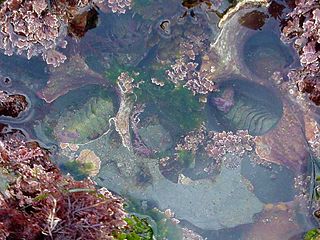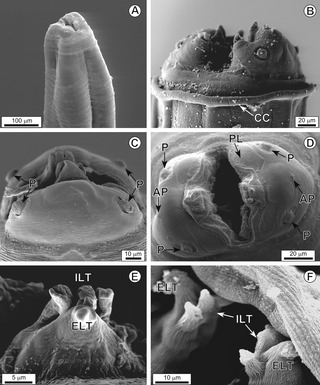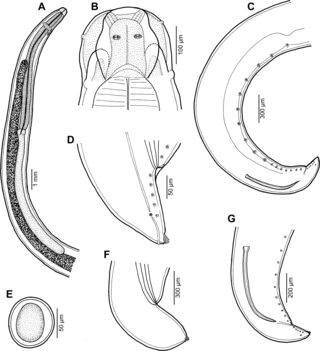
Nematomorpha are a phylum of parasitoid animals superficially similar to nematode worms in morphology, hence the name. Most species range in size from 50 to 100 millimetres, reaching 2 metres (79 in) in extreme cases, and 1 to 3 millimetres in diameter. Horsehair worms can be discovered in damp areas, such as watering troughs, swimming pools, streams, puddles, and cisterns. The adult worms are free-living, but the larvae are parasitic on arthropods, such as beetles, cockroaches, mantises, orthopterans, and crustaceans. About 351 freshwater species are known and a conservative estimate suggests that there may be about 2000 freshwater species worldwide. The name "Gordian" stems from the legendary Gordian knot. This relates to the fact that nematomorphs often coil themselves in tight balls that resemble knots.

Benthos, also known as benthon, is the community of organisms that live on, in, or near the bottom of a sea, river, lake, or stream, also known as the benthic zone. This community lives in or near marine or freshwater sedimentary environments, from tidal pools along the foreshore, out to the continental shelf, and then down to the abyssal depths.

The snailfishes or sea snails are a family of marine ray-finned fishes. These fishes make up the Liparidae, which is classified within the order Scorpaeniformes.
Pearlfish are marine fish in the ray-finned fish family Carapidae. Pearlfishes inhabit the tropical waters of the Atlantic, Indian, and Pacific Oceans at depths to 2,000 m (6,600 ft), along oceanic shelves and slopes. They are slender, elongated fish with no scales, translucent bodies, and dorsal fin rays which are shorter than their anal fin rays. Adults of most species live symbiotically inside various invertebrate hosts, and some live parasitically inside sea cucumbers. The larvae are free living.

The Anisakidae are a family of intestinal nematodes (roundworms). The larvae of these worms can cause anisakiasis when ingested by humans, in raw or insufficiently cooked fish.

Marine invertebrates are the invertebrates that live in marine habitats. Invertebrate is a blanket term that includes all animals apart from the vertebrate members of the chordate phylum. Invertebrates lack a vertebral column, and some have evolved a shell or a hard exoskeleton. As on land and in the air, marine invertebrates have a large variety of body plans, and have been categorised into over 30 phyla. They make up most of the macroscopic life in the oceans.

The nematodes, roundworms or eelworms constitute the phylum Nematoda. They are a diverse animal phylum inhabiting a broad range of environments. Most species are free-living, feeding on microorganisms, but there are many that are parasitic. The parasitic worms (helminths) are the cause of soil-transmitted helminthiases.

Like humans and other animals, fish suffer from diseases and parasites. Fish defences against disease are specific and non-specific. Non-specific defences include skin and scales, as well as the mucus layer secreted by the epidermis that traps microorganisms and inhibits their growth. If pathogens breach these defences, fish can develop inflammatory responses that increase the flow of blood to infected areas and deliver white blood cells that attempt to destroy the pathogens.

The Clarion-Clipperton Zone (CCZ) or Clarion-Clipperton Fracture Zone is an environmental management area of the Pacific Ocean, administered by the International Seabed Authority (ISA). It includes the Clarion Fracture Zone and the Clipperton Fracture Zone, geological submarine fracture zones. Clarion and Clipperton are two of the five major lineations of the northern Pacific floor, and were discovered by the Scripps Institution of Oceanography in 1954. The CCZ is regularly considered for deep-sea mining due to the abundant presence of manganese nodules.

Huffmanela is a genus of parasitic nematodes, belonging to the family Trichosomoididae.

Lethrinus lentjan, the pink ear emperor, redspot emperor, purple ear emperor or purple-headed emperor, is a species of marine ray-finned fish belonging to the family Lethrinidae, the emperors and emperor breams. This fish is found in the Indo-Pacific region.

Cucullanus is a genus of parasitic nematodes. The genus includes more than 100 species.
Phasmarhabditis (Greek: Phasma = (φάσμα ; rhabditis = is a genus of bacterial-feeding nematodes which are facultative parasites whose primary hosts are terrestrial gastropods. The name comes from Greek: Phasma- (φάσμα ; rhabditis = rod-like (ῥάβδος. The genus is made up of 18 species including P. hermaphrodita, P. californica, P. neopapillosa, P. papillosa, P. apuliae, P. bohemica, P. bonaquaense, P. huizhouensis, P. nidrosiensis, P. valida and P. tawfiki.

Physalopteridae is a family of spirurian nematodes, which belongs to the superfamily Physalopteroidea. Like all nematodes, they have neither a circulatory nor a respiratory system.

Cystidicolidae is a family of spirurian nematodes. It was described by Skrjabin in 1946. All members of the family are parasites of fish.

Moravecnema is a genus of parasitic nematodes, belonging to the family Cystidicolidae. Species of Moravecnema are parasitic as adults in the gastrointestinal tract of fish. According to the World Register of Marine Species, the genus currently (2019) includes a single species, Moravecnema segonzaci, which is a parasite in a deep-sea fish.
Spinitectoides is a genus of parasitic nematodes, belonging to the family Cystidicolidae. Species of Spinitectoides are parasitic as adults in the gastrointestinal tract of fish. According to the World Register of Marine Species, the genus currently (2019) includes a single species, Spinitectoides berlandi.
Prospinitectus is a genus of parasitic nematodes, belonging to the family Cystidicolidae. Species of Prospinitectus are parasitic as adults in the gastrointestinal tract of Tuna fish.

Regalecus russelii, or Russell's oarfish, is a species of oarfish in the family Regalecidae. It is a broadly-distributed marine fish, found in waters in the bathypelagic zone. R. russelii is a scaleless, elongate and ribbonlike fish, growing up to 8 meters in length.

Hysterothylacium is a genus of parasitic roundworms in the family Raphidascarididae. As of 2020 it consists of over 70 species and is considered one of the largest of the ascaridoid genera parasitising fish.














